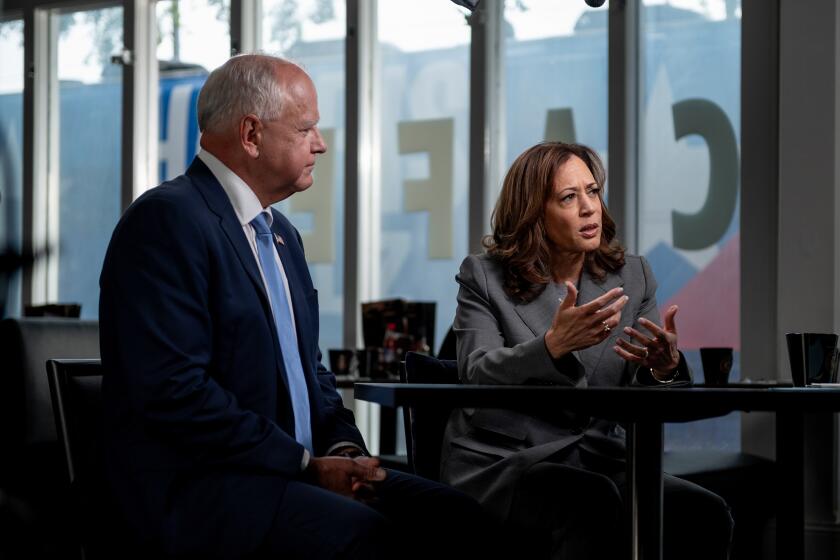Column: Cable’s answer to cool new streaming services? Soaring internet prices
The good news: More “skinny bundles” of pay-TV channels will be available to consumers as a growing number of households abandon fat programming packages and seek cheaper online streaming options for home entertainment.
The bad news: Analysts say cable and phone companies, quickly adapting to this new reality, will keep jacking up internet prices to make sure your monthly bill stays sky-high.
The dual changes reflect the two sides of the telecom marketplace. On the one hand, consumers are making their voices heard in their embrace of new technology to avoid paying for hundreds of channels they may never watch.
This signals the gradual demise of a business model that has allowed pay-TV companies to take advantage of people for decades.
At the same time, the near-monopoly power that many cable and phone companies enjoy for high-speed internet service allows them to continue dictating terms, setting prices far beyond the cost of maintaining or improving broadband networks.
“We’re in the middle of a massive reinvention of the industry,” said telecom analyst and consultant Jeff Kagan. “Everything is changing.”
He noted that pay-TV service is no longer the main source of revenue for many cable companies — it’s internet. To maintain growth, therefore, these companies have to keep raising internet prices.
“This is the only way to keep shareholders happy,” Kagan told me.
In a recent report, investment bank UBS estimated there will be 24 million streaming-TV subscribers by the end of 2022, or about a quarter of all pay-TV customers.
This reflects the growing popularity of Netflix, Hulu, Amazon Prime and other online services, along with skinny-bundle providers such as Dish Network’s Sling TV and AT&T’s DirecTV Now.
It’s long been an open secret in the pay-TV business that consumers were being forced to shell out for many more channels than they desired. According to Nielsen, the typical pay-TV subscriber watches only 17 channels on a regular basis.
Service providers routinely defended their high monthly bills by saying it wasn’t their fault — blame those darn TV networks that keep boosting programming costs.
That excuse no longer holds water as streaming and skinny bundles take hold, making the average $100 cable bill increasingly indefensible.
So the industry has switched to saying internet-loving customers are now paying primarily for network upgrades.
“We’ve invested in adding capacity and increasing speeds,” said Sena Fitzmaurice, a spokeswoman for cable giant Comcast.
Brian Dietz, a spokesman for NCTA-the Internet & Television Assn., an industry group, said average internet prices actually are lower than they were three years ago and speeds are increasing.
“That is a good-news story for consumers,” he said.
In fact, according to the Bureau of Labor Statistics, internet prices were down just 0.4% last month from three years before and they’re now clearly on the upswing. Since April, internet prices have risen 4%.
And while speeds are indeed getting faster, the United States still lags much of the developed world.
A recent study by Cable.co.uk, a British research firm, found the average U.S. internet speed is 25.86 megabits per second, which is a far cry from world leader Singapore (60.39 Mbps), and behind the likes of Sweden (46 Mbps), Belgium (36.71 Mbps) and Spain (27.19 Mbps).
Meanwhile, the study found that the average American pays $66 monthly for high-speed internet service, compared with $55 in Canada, $41 in Britain and $34 in Germany. As with healthcare, Americans pay more and get less than their economic peers.
A big reason for that: lack of competition.
“In most parts of the country, there are only one or two companies providing broadband internet,” said Jimmy Schaeffler, a telecom analyst with the Carmel Group. “They’re a monopoly or a duopoly, and the consumer be damned.”
A recent report by the Federal Communications Commission found that “broadband is not being deployed to all Americans in a reasonable and timely fashion,” and the speed many internet customers receive “may be roughly half of advertised speeds.”
The National Digital Inclusion Alliance reported the other day that AT&T and Verizon are charging some internet customers broadband rates even in areas lacking sufficient infrastructure for broadband speeds.
The telecom industry, I suspect, doesn’t care if you realize it’s found new ways to fleece you.
A recent survey by Consumer Reports found that only 38% of cable subscribers are “very” or “completely” happy with their service. The vast majority, in other words, see plenty of room for improvement.
Paul Gallant, a former FCC official who is now an analyst with Cowen & Co., said cable companies routinely justify their higher prices to telecom authorities by pointing to yearly increases in internet speeds, even if customers see no difference in service quality.
“It’s a pretty shrewd argument by the industry to keep regulators out of their business,” he said.
Yet even though every analyst I spoke with said internet prices will keep rising for the immediate future, there’s reason for hope.
The big wild card in coming years is the rollout of 5G wireless networks — superfast service that could make high-speed cable and phone lines obsolete, especially in big cities.
This could allow the likes of AT&T, Verizon and Sprint — and maybe even Google, Facebook or Amazon — to offer wireless broadband internet that can compete with the speed and reliability of cable.
And that should be a real wake-up call for the cable industry. It’s been a long time since they’ve had to actually compete for your business.
“Cable companies now have an immense amount of pricing power,” said Corey Barrett, a senior media analyst at research firm M Science. “That changes when a Google or some other player steps in.”
Faster speeds and competitive prices?
Now that would be a good-news story for consumers.
David Lazarus’ column runs Tuesdays and Fridays. He also can be seen daily on KTLA-TV Channel 5 and followed on Twitter @Davidlaz. Send your tips or feedback to david.lazarus@latimes.com.
More to Read
The biggest entertainment stories
Get our big stories about Hollywood, film, television, music, arts, culture and more right in your inbox as soon as they publish.
You may occasionally receive promotional content from the Los Angeles Times.







